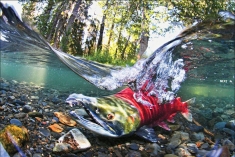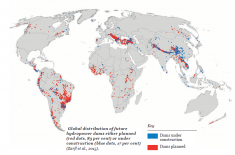Our Unique Freshwater Treasures at Risk
In the world’s largest dam removal, the Elwha and the Glines Canyon dams on the Elwha River in the Pacific Northwest tumbled down in 2011 and 2014 respectively. Within a few years, riverine life has bounced back at an unexpected pace. Salmon, which had lost 98% of their populations after the river was dammed, make their way upstream to spawn in the thousands, and otters, beavers and birds are feasting on the renewed riches.
Unfortunately, the restoration of the Elwha River is still the exception rather than the rule. On the other side of the Pacific Ocean, thousands of river dolphins thrived in the Yangtze River only 50 years ago. By 1994, fewer than 100 individuals remained, and by 2006, the Yangtze dolphin had become extinct. Pollution, dam building and reckless navigation destroyed a proud branch on the tree of life in the blink of an eye.
According to the 2016 Living Planet Report which WWF published last week, freshwater species may be following the fate of the Yangtze dolphin on a massive scale. Based on the observation of more than 800 species over many decades, the report finds that freshwater species have on average lost no less than 81% of their populations between 1970 and 2012.
Population loss is affecting all the world’s habitats, but the losses are most dramatic in freshwater ecosystems. The fishes, amphibians, reptiles, mammals and birds that inhabit our rivers and lakes are losing population more than twice as fast as land-based and marine species. Across all ecosystems, the observed populations declined by 58% between 1970 and 2012.
The authors of the new report looked into the reasons for the alarming loss of freshwater populations. By far the most important cause is the loss and degradation of habitats for example through dam building and sand mining. Nearly 70% of all migratory fishes are threatened by changes in their habitats. Over-fishing, invasive species, pollution and climate change are other factors affecting freshwater populations.
The WWF report confirms the findings of earlier in-depth studies such as the Millennium Ecosystem Assessment and the Global Biodiversity Outlooks. Given the scientific evidence, it is misleading and cynical for dam builders and their allies to claim that hydropower is a clean and green form of energy.
More than 5,000 large hydropower dams and thousands of kilometers of levees currently affect 48% of the global river volume. Another 3,700 hydropower dams were under construction or at the planning stage in early 2014. The WWF report finds that if all these dams were built, natural flows would be lost for 93% of all river volume.
“Freshwater habitats,” the new report states, “carry immense importance for life on Earth. Freshwater accounts for only 0.01% of the world’s water and covers approximately 0.8% of the Earth’s surface but provides a habitat for almost 10% of the world’s known species.” It is extremely depressing to imagine what would happen to this unique ecological treasure if all the dams under construction and preparation were indeed built.
“There is a clear challenge for humanity to alter our course so that we operate within the environmental limits of our planet and maintain or restore resilience of ecosystems,” the WWF study concludes. As the example of dam removal on the Elwha River demonstrates, freshwater ecosystems can bounce back quickly if we remove the factors that impede and strangle them. The good news is that the tide has recently begun to turn against large dams. We will elaborate this in a series of blog posts in the coming weeks.
WWF, Living Planet Report 2016, Risk and Resilience in a New Era, October 2016.





